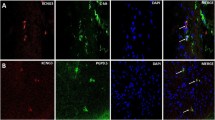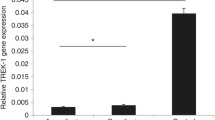Abstract
Aim of the study
Potassium (K+) channels with a two-pore domain (K2P) are a large family of hyperpolarising ion channels which play a key role in cell excitability. This family comprises three members: TREK-1, TREK-2 and TRAAK. TRAAK channels have previously been reported to be expressed in murine enteric ganglia. To date, no data exist regarding TRAAK channel expression in the human colon. Thus, we designed this study to investigate TRAAK gene expression in the normal human colon and in Hirschsprung’s disease (HSCR).
Methods
HSCR tissue specimens (n = 6) were collected at the time of pull-through surgery, while control samples were obtained at the time of colostomy closure in patients with imperforate anus (n = 6). qRT-PCR analysis was undertaken to quantify TRAAK gene expression, and immunolabelling of TRAAK proteins was visualized using confocal microscopy.
Main results
Confocal microscopy revealed TRAAK protein expression within both neurons and interstitial cells of Cajal in the myenteric plexus, with a reduction in both ganglionic HSCR colon and aganglionic HSCR colon, compared to controls. qRT-PCR analysis revealed a significant downregulation of the TRAAK gene in both aganglionic and ganglionic HSCR specimens compared to controls (p < 0.05).
Conclusions
TRAAK gene expression is significantly downregulated in HSCR colon, suggesting a role for these ion channels in colonic neurotransmission. TRAAK downregulation within ganglionic specimens highlights the dysfunctional nature of ganglia in this region.


Similar content being viewed by others
References
Lesage F, Lazdunski M (2000) Molecular and functional properties of two-pore-domain potassium channels. Am J Physiol Renal Physiol 279(5):F793–801. https://doi.org/10.1152/ajprenal.2000.279.5.F793
Sanders KM, Koh SD (2006) Two-pore-domain potassium channels in smooth muscles: new components of myogenic regulation. J Physiol 570(Pt 1):37–43. https://doi.org/10.1113/jphysiol.2005.098897
Brohawn SG (2015) How ion channels sense mechanical force: insights from mechanosensitive K2P channels TRAAK, TREK1, and TREK2. Ann N Y Acad Sci 1352:20–32. https://doi.org/10.1111/nyas.12874
Tomuschat C, O'Donnell AM, Coyle D, Dreher N, Kelly D, Puri P (2016) Altered expression of a two-pore domain (K2P) mechano-gated potassium channel TREK-1 in Hirschsprung's disease. Pediatr Res 80(5):729–733. https://doi.org/10.1038/pr.2016.140
Ma R, Seifi M, Papanikolaou M, Brown JF, Swinny JD, Lewis A (2018) TREK-1 channel expression in smooth muscle as a target for regulating murine intestinal contractility: therapeutic implications for motility disorders. Front Physiol 9:157. https://doi.org/10.3389/fphys.2018.00157
Menezes M, Corbally M, Puri P (2006) Long-term results of bowel function after treatment for Hirschsprung's disease: a 29-year review. Pediatr Surg Int 22(12):987–990. https://doi.org/10.1007/s00383-006-1783-8
Menezes M, Pini Prato A, Jasonni V, Puri P (2008) Long-term clinical outcome in patients with total colonic aganglionosis: a 31-year review. J Pediatr Surg 43(9):1696–1699. https://doi.org/10.1016/j.jpedsurg.2008.01.072
Mc Laughlin D, Friedmacher F, Puri P (2012) Total colonic aganglionosis: a systematic review and meta-analysis of long-term clinical outcome. Pediatr Surg Int 28(8):773–779
O'Donnell AM, Coyle D, Puri P (2015) Decreased expression of hyperpolarisation-activated cyclic nucleotide-gated channel 3 in Hirschsprung's disease. World J Gastroenterol 21(18):5635–5640. https://doi.org/10.3748/wjg.v21.i18.5635
O’Donnell AM, Nakamura H, Puri P (2019) Altered ryanodine receptor gene expression in Hirschsprung's disease. Pediatr Surg Int 35(9):923–927. https://doi.org/10.1007/s00383-019-04504-2
O'Donnell AM, Nakamura H, Tomuschat C, Marayati NF, Puri P (2019) Altered expression of KCNG3 and KCNG4 in Hirschsprung's disease. Pediatr Surg Int 35(2):193–197. https://doi.org/10.1007/s00383-018-4394-2
O'Donnell AM, Nakamura H, Tomuschat C, Marayati NF, Puri P (2019) Abnormal Scn1b and Fxyd1 gene expression in the pulled-through ganglionic colon may influence functional outcome in patients with Hirschsprung's disease. Pediatr Surg Int 35(1):9–14. https://doi.org/10.1007/s00383-018-4370-x
Author information
Authors and Affiliations
Corresponding author
Additional information
Publisher's Note
Springer Nature remains neutral with regard to jurisdictional claims in published maps and institutional affiliations.
Rights and permissions
About this article
Cite this article
O’Donnell, AM., Nakamura, H., Parekh, B. et al. Decreased expression of TRAAK channels in Hirschsprung’s disease: a possible cause of postoperative dysmotility. Pediatr Surg Int 35, 1431–1435 (2019). https://doi.org/10.1007/s00383-019-04572-4
Accepted:
Published:
Issue Date:
DOI: https://doi.org/10.1007/s00383-019-04572-4




